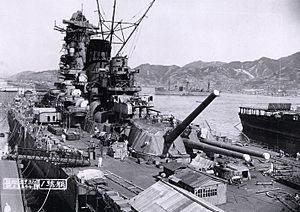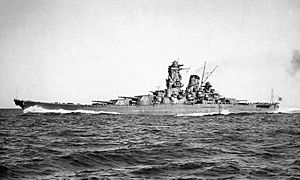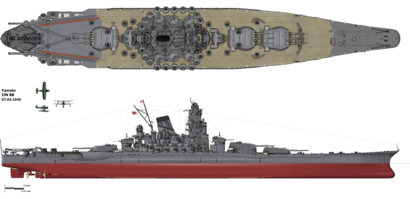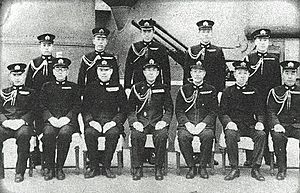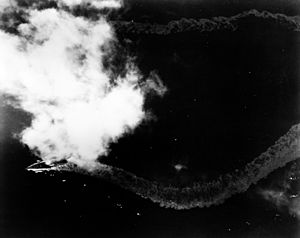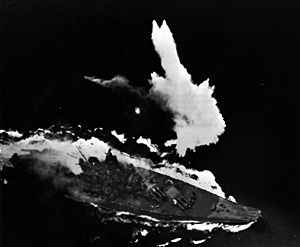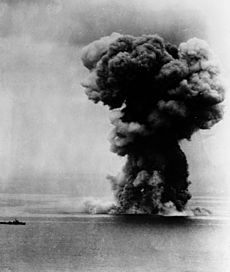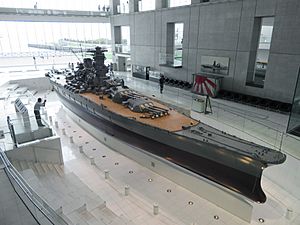Japanese battleship Yamato facts for kids
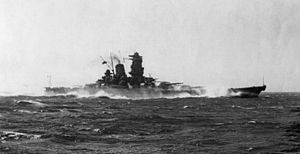
Yamato undertaking sea trials in the Bungo Channel, 20 October 1941
|
|
Quick facts for kids History |
|
|---|---|
| Name | Yamato |
| Namesake | Yamato Province, and an archaic name for Japan |
| Ordered | March 1937 |
| Builder | Kure Naval Arsenal |
| Laid down | 4 November 1937 |
| Launched | 8 August 1940 |
| Commissioned | 16 December 1941 |
| Stricken | 31 August 1945 |
| Fate | Sunk by American planes during Operation Ten-Go, 7 April 1945 |
| General characteristics (as built) | |
| Class and type | Yamato-class battleship |
| Displacement | |
| Length | 263 m (862 ft 10 in) (o/a) |
| Beam | 38.9 m (127 ft 7 in) |
| Draft | 11 m (36 ft 1 in) |
| Installed power | |
| Propulsion | 4 shafts; 4 steam turbines |
| Speed | 27 knots (50 km/h; 31 mph) |
| Range | 7,200 nmi (13,300 km; 8,300 mi) at 16 knots (30 km/h; 18 mph) |
| Complement | 3,233 |
| Armament |
|
| Armor |
|
| Aircraft carried | 7 Nakajima E8N or Nakajima E4N |
| Aviation facilities | 2 catapults |
Yamato (大和) was a giant battleship built for the Imperial Japanese Navy (IJN) just before World War II. She and her sister ship, Musashi, were the biggest and most powerful battleships ever made. They weighed almost 72,000 tons when fully loaded. Their main guns were 46 cm (18.1 inch) Type 94 guns, the largest ever put on a warship.
Yamato was named after an old Japanese province and is also an ancient name for Japan. She was designed to fight the larger fleet of the United States, Japan's main rival in the Pacific Ocean. Her construction started in 1937. She was officially ready for duty a week after the attack on Pearl Harbor in December 1941.
Throughout 1942, Yamato was the flagship (the ship where the commander stays) of the Combined Fleet. In June 1942, Admiral Isoroku Yamamoto led the fleet from Yamato's bridge during the Battle of Midway. This battle was a huge loss for Japan. In early 1943, Musashi became the flagship. Yamato spent the rest of 1943 moving between Japanese naval bases like Truk and Kure.
In December 1943, an American submarine hit Yamato with a torpedo. She needed repairs at Kure. While there, she also got more anti-aircraft guns and radar in early 1944. She was at the Battle of the Philippine Sea in June 1944, but she didn't play a big part.
Yamato only fired her main guns at enemy ships once. This was in October 1944 during the Battle of Leyte Gulf in the Philippines. She faced a small group of US Navy escort carriers called "Taffy 3" in the Battle off Samar. The Japanese ships turned back after American air attacks made them think they were fighting a much stronger US carrier fleet.
By early 1945, Japan's navy was much weaker and had very little fuel. In a desperate move to stop the Allies, Yamato was sent on a one-way mission to Okinawa in April 1945. Her orders were to reach the island, run aground, and fight until she was destroyed. This was meant to protect Okinawa. However, US submarines and aircraft spotted her south of Kyushu. On April 7, 1945, American planes sank her, and most of her crew were lost.
Contents
Building the Giant Battleship
In the 1930s, Japan wanted to expand its empire. It left the League of Nations in 1934 and stopped following naval treaties. These treaties limited the size of warships. After leaving the treaties, the Imperial Japanese Navy started designing the new Yamato class of battleships. Japan knew it couldn't build as many ships as the United States. So, they designed the 70,000-ton Yamato-class ships to fight many enemy battleships at once.
The building of Yamato started at the Kure Naval Arsenal in Hiroshima Prefecture on November 4, 1937. The dock had to be made deeper to fit her huge hull. Special cranes that could lift up to 350 tons were installed. Building was kept very secret. A canopy was even put over part of the drydock to hide the ship from view. Yamato was launched on August 8, 1940. Japan worked hard to keep the ship's existence and details a secret from American intelligence.
Powerful Weapons
Yamato's main guns were nine 46 cm (18.1 inch) Type 94 guns. These were the largest guns ever put on a warship. Each gun was 21.13 meters (69.3 feet) long and weighed 147.3 tons. They could fire powerful shells up to 42 kilometers (26 miles) away.
Her secondary weapons included twelve 155 mm (6.1 inch) guns in four turrets. She also had twelve 12.7 cm (5 inch) guns in six twin mounts. These guns were taken from other Japanese cruisers. Yamato also carried twenty-four 25 mm (1 inch) anti-aircraft guns.
In 1944 and 1945, Yamato was updated. She had six 155 mm guns and twenty-four 127 mm guns. The number of 25 mm anti-aircraft guns was greatly increased to 162.
Battles and Missions
Early Missions
In October or November 1941, Yamato had her sea trials. She reached her fastest speed of 27.4 knots (50.7 km/h). She was officially ready for duty on December 16, 1941, earlier than planned. This was a quiet ceremony to keep her details secret.
On February 12, 1942, Yamato became the flagship of Admiral Isoroku Yamamoto's Japanese Combined Fleet. Yamamoto planned a big battle against the United States Navy at Midway Island. Yamato left Hiroshima Bay on May 27. However, US codebreakers knew Japan's plans. The Battle of Midway was a disaster for Japan. They lost four aircraft carriers. Yamamoto was on Yamato's bridge, but his battle plan spread his forces too wide. Yamato was too far away to join the fight.
Yamato sailed to Truk on August 17, 1942. An American submarine, USS Flying Fish, tried to torpedo her, but missed. Yamato stayed at Truk during the Guadalcanal campaign. She didn't have the right ammunition for shore attacks, and her fuel use was too high.
On February 11, 1943, Yamato's sister ship, Musashi, took over as the Combined Fleet flagship. Yamato left Truk on May 8, 1943, for repairs in Japan. She spent nine days in dry dock. In late July, she had more major upgrades. She returned to Truk on August 16. She joined a large task force to respond to American attacks. The fleet returned to Truk on October 26.

On December 25, 1943, while carrying troops and supplies from Yokosuka to Truk, Yamato was hit by a torpedo from the American submarine Skate. The torpedo made a large hole in her side. About 3,000 tons of water flooded into the ship. She made it to Truk for temporary repairs. Then, she went to Kure for full repairs.
Yamato was in dry dock at Kure until February 3, 1944. Her hull was strengthened. On February 25, Yamato and Musashi were moved to the Second Fleet.
From February 25 to March 18, 1944, Yamato received more upgrades. Two of her 155 mm gun turrets were removed. They were replaced with six 127 mm anti-aircraft guns. Many more 25 mm anti-aircraft guns were added, bringing the total to 162. Her radar systems were also improved. After trials, Yamato left Kure on April 21. She carried soldiers and supplies to the Philippines. Then, she joined Vice-Admiral Jisaburo Ozawa's Mobile Fleet in Malaya.
Battle of the Philippine Sea
In early June, Yamato and Musashi were used to carry troops again. This time, they were going to reinforce the island of Biak. But the mission was canceled because American carriers attacked the Mariana Islands. The Japanese Navy gathered its remaining strength for a big fight. However, the Japanese navy was much smaller and less experienced than the U.S. Pacific Fleet.
From June 19 to 23, 1944, Yamato protected Ozawa's Mobile Fleet during the Battle of the Philippine Sea. American pilots called this battle "The Great Marianas Turkey Shoot." Japan lost three aircraft carriers and 426 planes. Yamato's only notable action was accidentally firing at her own returning Japanese planes.
After the battle, Yamato returned to Japan for refueling and rearming. She received five more triple 25 mm anti-aircraft mounts. Many flammable items were removed from the ship to prevent fires. Yamato left Japan on July 8 with other battleships and cruisers. She sailed to the Lingga Islands to be closer to fuel supplies. She stayed there for three months.
Battle of Leyte Gulf
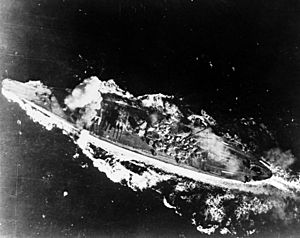
From October 22 to 25, 1944, Yamato took part in one of the biggest naval battles in history: the Battle of Leyte Gulf. This battle was a Japanese response to the American invasion of the Philippines. On October 18, Yamato was painted black for a nighttime journey.
On October 23, American submarines attacked the Japanese force. They sank two heavy cruisers and damaged another. Admiral Takeo Kurita, the commander, moved his flag to Yamato.
Fighting in the Sibuyan Sea
The next day, October 24, the Battle of the Sibuyan Sea began. American carrier planes attacked the Japanese force. Yamato was hit by two bombs and had one near miss. She took on about 3,370 tons of water but could still fight. However, her sister ship, Musashi, was heavily attacked and sank after being hit by 17 bombs and 19 torpedoes.
Battle off Samar
Admiral William Halsey Jr., the commander of the main American battle group, left the Leyte Gulf area on the evening of October 24. He thought Kurita's force had turned back. So, Halsey took his powerful Task Force 38 to chase a Japanese decoy group. This decoy group had one fleet carrier, three light carriers, and two battleship-carriers. The trick worked, drawing away many American ships and planes.
During the night, Kurita's force sailed through the San Bernardino Strait. At dawn, in the Battle off Samar, they attacked a small American group. This group, called "Taffy 3," had six escort carriers, three destroyers, and four destroyer escorts.
At the start of this battle, Yamato fired her main guns at enemy ships for the only time in her career. She hit several American ships. After Yamato hit the escort carrier USS Gambier Bay, torpedoes were seen heading for Yamato. The battleship had to turn away to avoid them and couldn't rejoin the fight.
Even though they only had torpedoes and 5-inch guns, the small American ships, supported by planes from Taffy 3's escort carriers, attacked fiercely. Kurita believed his ships were fighting a full American task force with many fleet carriers. A false report made Kurita order his force to turn back. Yamato was not seriously damaged in this battle.
After the battle, Yamato and the remaining ships returned to Brunei. On November 15, 1944, Yamato became the flagship of the Second Fleet. On November 21, while sailing to Kure Naval Base, Yamatos group was attacked by the submarine USS Sealion. The battleship Kongō and a destroyer were sunk. Yamato went into dry dock for repairs and more anti-aircraft upgrades. On November 25, Captain Aruga Kōsaku became Yamatos commander.
Operation Ten-Go: The Final Mission
On January 1, 1945, Yamato was moved to the reactivated 1st Battleship Division. On March 19, American carrier planes attacked Kure Harbour. Yamato had only minor damage from near misses and one bomb hit on her bridge.
As the Allies prepared to invade Japan, they attacked Okinawa on April 1. The Imperial Japanese Navy planned a desperate mission called Operation Ten-Go. Yamato and nine escort ships (one cruiser and eight destroyers) would sail to Okinawa. There, they would attack Allied forces with kamikaze planes and army units on the island. After that, Yamato would run aground and fight until destroyed.
For this mission, Yamato took on a full load of ammunition. She also received extra fuel, about 60% of her capacity. The ships left Tokuyama on April 6.
However, the Allies had intercepted and decoded Japan's radio messages. They knew about Operation Ten-Go. On April 6, American submarines spotted Yamatos force. They reported Yamatos position to the main American carrier strike force.
Admiral Raymond Spruance ordered six battleships to prepare to fight Yamato. But these orders were changed. Instead, Admiral Marc Mitscher's aircraft carriers would attack. Still, the battleships, cruisers, and destroyers were sent to stop the Japanese force before it reached the vulnerable transport ships.
Yamato's crew was ready for anti-aircraft action by dawn on April 7. The first Allied planes spotted the Japanese force at 08:23. For the next five hours, Yamato fired special anti-aircraft shells at the planes, but couldn't stop them from following. At 10:00, Yamato detected aircraft on radar. An hour later, American F6F Hellcat fighters appeared. No Japanese planes showed up.
Around 12:30, 280 bomber and torpedo bomber planes arrived over the Japanese force. The destroyer Asashimo was sunk. The Japanese force increased speed to 24 knots (44 km/h). The destroyers began circling Yamato for defense.
The first planes attacked at 12:37. Yamato was not hit for four minutes. But at 12:41, two bombs destroyed two of her anti-aircraft mounts and made a hole in the deck. A third bomb hit her radar room. At 12:45, a torpedo hit Yamato's front port side. At 12:46, two more bombs hit her port side, damaging a gun turret and its magazines. Shortly after, up to three more torpedoes hit Yamato. These hits disabled a boiler room and caused flooding. The attack ended around 12:47. Yamato was leaning 5–6° to port. Counterflooding (flooding compartments on the other side) reduced the list to 1°. Her speed was slightly reduced, and many anti-aircraft gun crews were injured.
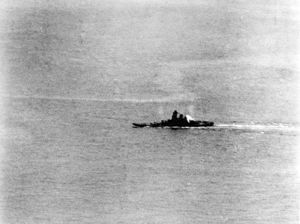
The second attack started just before 13:00. Dive bombers attacked from above, while torpedo bombers came from all directions. Yamato's anti-aircraft guns were overwhelmed. Three or four torpedoes hit Yamato on the port side, and one on the starboard. These hits caused more flooding in engine and fire rooms. This left Yamato leaning 15–18° to port. Counterflooding reduced this to 10°. But the list meant her main guns couldn't fire, and her speed was limited to 18 knots (33 km/h).
The third and most damaging attack began around 13:40. At least four bombs hit the ship's upper structure, causing many casualties among her gun crews. Many near misses damaged her outer plating. Most seriously, four more torpedoes hit her. Three exploded on the port side, causing more flooding and disabling the steering gear room. With the auxiliary steering room already flooded, the ship lost control and became stuck turning to starboard. The fourth torpedo likely hit the starboard outer engine room, which was already being counterflooded. This hit sped up the flooding and trapped many crewmen.
At 14:02, the order was given to abandon ship. By this time, Yamato's speed had dropped to 10 knots (19 km/h), and she was leaning more. Fires were out of control. Alarms warned of dangerous temperatures in the forward main gun magazines. The pumps to flood the magazines and prevent an explosion were destroyed.
At 14:05, the cruiser Yahagi sank. At the same time, a final group of torpedo bombers attacked Yamato from her starboard side. Her list was so severe that the torpedoes, set to a depth of 6.1 meters (20 feet), hit the bottom of her hull. The battleship continued to roll to port. By 14:20, the power went out, and her remaining anti-aircraft guns began to fall into the sea. Three minutes later, at 14:23, Yamato capsized (turned over). Her huge 46 cm gun turrets fell off. As she rolled, the suction pulled swimming crewmen back towards the ship. When she rolled about 120°, one of her front magazines exploded in a massive blast. The huge mushroom cloud, over 6 kilometers (3.7 miles) high, was seen 160 kilometers (100 miles) away on Kyūshū.
Yamato sank quickly. An estimated 3,055 of her 3,332 crew were lost, including fleet commander Vice-Admiral Seiichi Itō. The few survivors were rescued by the four remaining destroyers, which returned to Japan.
From the first attack at 12:37 to the explosion at 14:23, Yamato was hit by at least 11 torpedoes and 6 bombs. There might have been two more torpedo and bomb hits, but this is not confirmed.
Finding the Wreck
It was hard to find and identify most Japanese warships lost in World War II because information was often unclear. In 1982, an expedition to the East China Sea found some wreckage, but couldn't confirm it was Yamato. A second expedition in 1984 took photos and videos. Later, one of the battleship's designers, Shigeru Makino, confirmed that it was Yamato's last resting place. The wreck lies 290 kilometers (180 miles) southwest of Kyushu, under 340 meters (1,115 feet) of water. It is in two main pieces: a bow section (the front two-thirds) and a separate stern section.
On July 16, 2015, Japanese lawmakers started discussing if it was possible to raise the ship from the ocean floor. They wanted to recover the remains of crew members trapped in the wreckage. In May 2016, the wreck was surveyed using digital technology. This gave a more detailed view and confirmed its identity. The video showed many details, like the Imperial chrysanthemum symbol on the bow, the huge propeller, and a detached main gun turret. This nine-minute video is shown at the Yamato Museum in Kure.
Yamato's Meaning in Culture
From the time they were built, Yamato and Musashi were very important in Japanese culture. These battleships showed the best of Japanese naval engineering. Their size, speed, and power represented Japan's strong will to protect its interests against the Western countries and the United States. Some Japanese people even believed their country could not fall as long as Yamato could fight.
Decades after the war, Yamato was remembered in many ways by the Japanese. The word "Yamato" is an old poetic name for Japan. So, the ship's name became a symbol for the end of the Japanese empire. In April 1968, a memorial tower was built at Cape Inutabu on Tokunoshima island. It honors the lives lost in Operation Ten-Go.
In October 1974, Leiji Matsumoto created a TV series called Space Battleship Yamato. It was about rebuilding the battleship as a starship and its journey to save Earth. This series was very popular. It led to many movies and more TV series. The series helped make space opera popular. After the war, as Japanese people tried to find new meaning in their lives, Yamato became a symbol of heroism.
In 2005, the Yamato Museum opened near the old Kure shipyards. The museum teaches about Japan's maritime history. It especially focuses on the battleship Yamato. The main attraction is a 26.3-meter (86.3 feet) long model of Yamato (1:10 scale).
Later that year, Toei released a movie called Yamato. It was based on a book and honored the 60th anniversary of the end of World War II. The movie tells the story of the sailors on the doomed battleship. It explores ideas of honor and duty. The film was a big success in Japan.
The 2019 Japanese film The Great War of Archimedes is based on a manga. It tells the story of a debate within the Japanese Navy about building aircraft carriers or a new battleship, which would become Yamato. The film starts with Yamato's sinking and ends with her being ready for duty.
See also
 In Spanish: Yamato (1941) para niños
In Spanish: Yamato (1941) para niños
- Battleships in World War II
- Bismarck-class battleship
- Iowa-class battleship
- King George V-class battleship (1939)
- Littorio-class battleship
- Richelieu-class battleship


